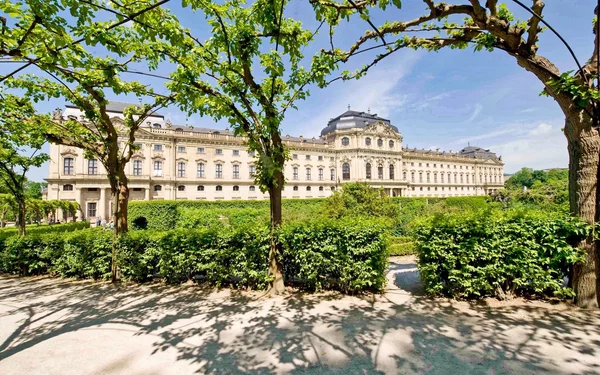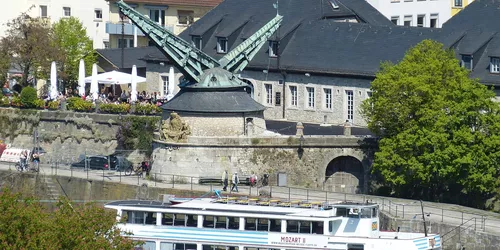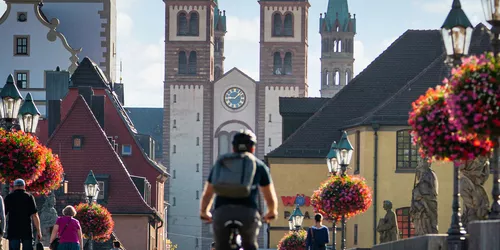Würzburg's old treasures
You've never seen Würzburg like this before! This city tour combines important religious and secular buildings in the city and rewards you at the end with a marvellous view over the city and the River Main.
Würzburg
4 h
8 km
It is difficult to choose from Würzburg's countless treasures. The beautiful university city lies nestled on the Main, surrounded by vineyards. For over 1000 years, the river and the wealthy and powerful prince-bishops with their architectural heritage have characterised the life and image of the city.
The Marienberg Fortress or the Prince-Bishops' Residence, a UNESCO World Heritage Site since 1981, would be reason enough to visit Würzburg. This also applies to the most beautiful of the city's many churches. This tour combines the most impressive sacred and secular buildings into a city and riverside walk, the literal highlight of which is a breathtaking view over the city and the River Main from the Fürstengarten.
A city tour for families, culture lovers and connoisseurs
Start and end station
Würzburg Hauptbahnhof
8 km / 4 Stunden
Würzburg Hauptbahnhof
Our tip: Please make sure to check your train connection and the expected capacity before you start your journey.
Schedule
Tour starts on Würzburg Hauptbahnhof
Direction
At the main railway station, the Franconian Apostle Kilian points you in the direction of the city centre with his blessing on the Kilian Fountain. You give him a friendly nod and decide to take a different route. On this tour, you will only cross the old town centre once and otherwise walk through green spaces, vineyards and along riverbanks.
First turn right to walk behind the bus station through the Ringpark towards the banks of the Main. Once you have crossed the Röntgenring and the tram tracks at the end of the park, stroll southwards along the Kranenkai until you reach the eponymous Alter Kranen, one of Würzburg's landmarks.
Old crane
The Main has been used for the transport and trade of timber since time immemorial and this section of the riverbank was first fortified as a quay in the mid-16th century. In the 17th and 18th centuries, trade became more regular and Prince-Bishop Adam Friedrich von Seinsheim wanted to strengthen this development by commissioning the construction of a harbour crane.
The imposing baroque crane was built between 1767 and 1773 and has not been in operation for around 180 years. However, the technology inside the crane house is still fully preserved and functional today. To achieve maximum lifting power, up to twelve people, known as crane or winch servants, had to set two pedal wheels, each with a diameter of over five metres, in motion at the same time. The longer of the two crane arms then has a maximum lifting capacity of one tonne, while the three metre shorter arm can lift 1.2 tonnes. They are mounted on rollers and can be rotated through 360 degrees.
In the past, trade was conducted around the crane, but today the Alte Kranen is a popular meeting place on Würzburg's Mainkai.
Mainkai
97070
Würzburg
Direction
You continue your walk along the Mainkai, pass the Japanese garden and finally take the stairs up to your second destination: the Old Main Bridge. In the evening, it often fills up with locals and guests who socialise over the famous "Brückenschoppen". In Franconia, a "Schoppen" is a quarter of a litre of wine, which the neighbouring restaurants and the bar of the local winegrowers' cooperative are happy to serve you.
Old Main Bridge Würzburg
Why wander into the distance? Würzburg's Old Main Bridge reminds quite a few people of the famous Charles Bridge in Prague. The similarity between the two stone arch bridges is partly due to the stone figures on either side of the carriageway. The twelve bridge figures in Würzburg date from the Baroque period.
However, the Old Main Bridge itself is much older than the figures. As early as 1120, the ferry service was replaced here by the first Romanesque stone bridge. At that time, the Main was a transport route for free-floating logs, which caused severe damage to the structure over time. After two hundred-year floods in 1342 and 1442, the structure was replaced by a new bridge made of natural stone in 1476.
Until 1886, the Old Main Bridge was the only river crossing in Würzburg. Until the 18th century, it was fortified for military purposes and almost completely covered with stalls. Würzburg was located on the important trade route from Regensburg to Frankfurt. This river crossing enabled the city to collect customs duties. The medieval gates at its entrances were demolished in the 18th and 20th centuries. After being blown up by German troops in April 1945, the fourth and fifth arches of the bridge were rebuilt in the spring of 1950. Since 1990, the Main can only be crossed here on foot or by bicycle.
Many of Würzburg's sights can be seen from the Old Main Bridge: the pilgrimage church of the Visitation of the Virgin Mary on the Nikolausberg, popularly known as the Käppele - a late work by Balthasar Neumann with magnificent rococo furnishings - as well as the Marienberg fortress towering over the city and Germany's largest contiguous vineyard, the Würzburger Stein. Last but not least, the "Alte Kranen", a baroque harbour crane dating back to 1773, and the silhouette of the city's towers can also be seen from the bridge.
Direction
It's nice to see the Marienberg fortress from down here, rising 100 metres above the river from steep vineyards. But aren't you also curious about the view of the old town from there?
Set off for a change of perspective! To do so, turn right briefly on the other bank of the Main and then left onto the Tellsteige. This leads you up the hill and around the fortress, which you enter on the side facing away from the city. You have climbed a long way up and have arrived deep in history.
Marienberg Fortress
There was a Celtic rampart here as early as 1000 BC. The oldest surviving building in the fortress is a small round church dating back to 704: St Mary's Church. The 40 metre high keep and the well house with its 100 metre deep cistern also bear witness to the more than 1300 year history of Marienberg Fortress.
The construction of an unusually large castle began around the year 1200. This was followed by extensions and expansions in the late Middle Ages and the Renaissance. From 1253 to 1719, Marienberg Fortress was the seat of the Würzburg prince-bishops. A siege in 1525 during the Peasants' War failed, but the Swedes succeeded in storming it 100 years later during the Thirty Years' War. The castle was subsequently surrounded by a ring of massive bastions during the Baroque period.
The vineyard at the foot of the fortress is the Schlossberg. The name is understandable, as the front part of the fortress is laid out like a castle. It essentially goes back to Prince-Bishop Julius Echter, a great builder, administrative reformer and important representative of the Counter-Reformation, who died at Marienberg Fortress in 1617.
At the eastern end of the fortress, the 1300 square metre Fürstengarten, a viewing platform with a garden in the style of the hidden Renaissance gardens of Italy, is laid out on a former gun platform. Accessible from the castle courtyard, it originally dates from 1650 to 1700 and was restored in the 1930s according to plans from the early 18th century.
The extensive fortifications extend as far as the River Main. The State Garden Show Park was created on this site after the 1990 State Garden Show.
Festung Marienberg
97082
Würzburg
Direction
For the descent, take the signposted path through the vineyards. Once you reach the bottom, walk along the riverbank and the lock. Maybe you'll be lucky and see some spectacular cargo being sluiced through.
From the Old Main Bridge, head down the ramp and into the centre of the old town. Here you can get an ice cream at the Fontana ice cream parlour and admire the Grafeneckart town hall. The town has used this building as its town hall for over 700 years. The tree painted on the façade replaced the lime tree in front of the building in the 16th century.
You stroll down Domstraße. But before you visit the cathedral itself, take a detour via Schustergasse and Schmalzmarkt, because you don't want to miss the Neumünster.
Its baroque west façade made of red brick blends in with the street front and gives little indication of the beautiful, large interior hidden behind the open staircase. Underneath, in the crypt of the church, you will find the modern tomb shrine of the three Franconian apostles Kilian, Kolonat and Totnan, the destination of the pilgrimage of St Kilian, which is still important in Franconia today.
Würzburg is unique. The most beautiful churches are right next door to each other here.
St Kilian's Cathedral
The fourth largest Romanesque church in Germany is dedicated to the patron saint of the diocese, the Franconian martyr Kilian. Today's building is the third church on this site and was built between 1040 and 1075 under Bishops Bruno and Adalbero.
The mighty interior surprises with its interesting mixture of art and architectural styles from Romanesque to modern. The funerary monuments of the Würzburg prince-bishops, especially the sculptures of Rudolph von Scherenberg and Lorenz von Bibra by Tilman Riemenschneider, are worthy of note.
The Romanesque baptismal font stands out in the centre of the nave of the church, while the mighty Klais organ with its 87 stops and 6,652 pipes is located in the large gallery on the west side of the nave. The valuable cathedral pulpit with the four evangelists at its base was designed by Michael Kern in the Renaissance style at the beginning of the 17th century. The entrance to the Schönborn family's burial chapel, designed by Balthasar Neumann, is located in the left transept.
Domstraße 40
97070
Würzburg
Direction
If you like, pay a visit to the Lusamgärtchen at the back of the Neumünster. A memorial stone commemorates the minstrel Walther von der Vogelweide, who is believed to have been buried here in 1230.
Turn right and walk past the Schönborn Chapel and the stately cathedral courtyards to Residenzplatz. At the top of the fountain is the figure of Franconia, the patron saint of Franconia. At her feet are three artists whose fates are closely linked to Würzburg: the minstrel Walther von der Vogelweide, the sculptor Tilman Riemenschneider and the painter Matthias Grünewald.
You are standing right in front of what is probably Würzburg's most famous piece of jewellery. Make sure you plan an hour to visit the inside of the Residenz.
Würzburg Residence
The Residenz is "the most uniform and extraordinary of all Baroque palaces". With this justification, it has been a UNESCO World Heritage Site since 1981. The Würzburg Residence is the work of the famous architect and prince-bishop's chief building director Balthasar Neumann. From the middle of the 18th century until secularisation, the expropriation of church property at the beginning of the 19th century, the residence was the seat of the Würzburg prince-bishops.
The history of this magnificent building begins at the beginning of the 18th century. At that time, Prince-Bishop Johann Philipp Franz von Schönborn won an embezzlement case and received 600,000 guilders. This money was to be used to build a palace. It was the age of absolutism, in which the ruler had to demonstrate his power and wealth through the size of his residence.
Prince-Bishop von Schönborn commissions the hitherto unknown architect Balthasar Neumann with the plans. The foundation stone is laid in 1720. The shell of the building is completed in 1744. Renowned European artists are engaged to design the interior. These included the Venetian Giovanni Battista Tiepolo, who created the largest continuous ceiling fresco in the world in the stairwell. Also the plasterer Antonio Bossi, famous for his work in the White Hall of the Residence. The building work ends in 1778 after almost 60 years of construction.
In the end, the Würzburg Residence is 168 metres long, 92 metres deep and has 360 rooms, of which around 40 can be visited today. Beneath the Residenz are the mighty baroque vaults of the Staatlicher Hofkeller, one of Würzburg's three large wine estates. The Hofkeller dates back to a deed of gift from 1128. This makes it the oldest documented winery in Germany.
Magnificent wrought-iron gates between the south wing of the Residence and the Envoy Building lead into the Court Garden. Its southern section is strictly symmetrical in the French Baroque style. Cone-shaped yew trees frame the fountain. Balthasar Neumann already had the idea of incorporating the Baroque city wall into the garden design. This is done in the eastern garden, which is designed in the style of Italian baroque gardens, where terraces halfway up the wall invite visitors to take a stroll. The night music of the Mozart Festival in June is particularly atmospheric against this backdrop.
Residenzplatz 2
97070
Würzburg
Tour ends on Würzburg Hauptbahnhof
Direction
Have you ever tasted the famous Franconian wine? Goethe wrote: "No other wine will taste good to me, and I am weary when I am deprived of my favourite potion."
On the north side of Residenzplatz, you have the opportunity to get to know the wines of the Staatlicher Hofkeller in the Vinothek in the Rosenbachpalais. The Staatlicher Hofkeller was owned without interruption by the respective rulers of the state, from the prince-bishops to the Bavarian king to the current owner, the Free State of Bavaria.
Your return journey through the greenery begins with a crossing of the Hofgarten and finally leads you back through the Ringpark to Würzburg Central Station.






















